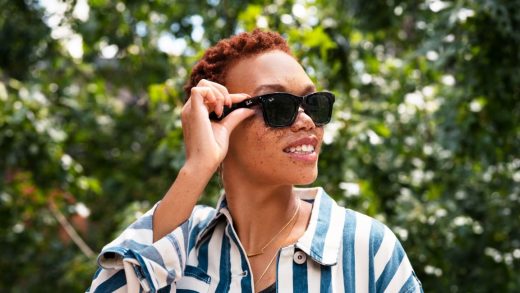Facebook gets in your Ray-Bans: A first look at its new smart glasses
Mark Zuckerberg’s mind often turns to the inadequacies of smartphones—especially their disruptive clunkiness as a tool for engaging with other humans.
“On the one hand, they provide so much value, so you’re not going to not use them,” explains Facebook’s CEO. “But I think the fact that we basically take this thing out of our pocket and kind of have our head stuck in it for a while is just not how we all want to interact.”
Zuckerberg has expressed variations on this sentiment when discussing Facebook’s Oculus VR headsets, its research into augmented-reality wearables, and its ambition to become “a metaverse company.” But in this particular case, he’s giving me the rationale behind Ray-Ban Stories, the new smart glasses that go on sale today, a year after he first teased them at the company’s Facebook Connect virtual conference.
A joint project between the Facebook Reality Labs hardware group and the 84-year-old Ray-Ban sunglasses brand—itself an arm of French-Italian optical-goods behemoth EssilorLuxottica—the new glasses are nowhere near as futuristic as Facebook’s other gambits to diminish the smartphone’s central place in our lives. In fact, the features they offer, starting at $299, are quite similar to products already on the market. You can use them to take photos and shoot brief videos while your phone remains in your pocket or purse—just like Snap’s Spectacles, which have been around for half a decade now. They also deliver open-ear audio for listening to music and making phone calls, as smart glasses from Amazon and Bose do.
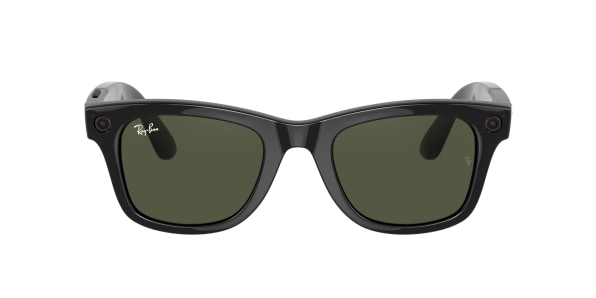
[Photo: courtesy of Ray-Ban]
And yet Ray-Ban Stories could be more than a mere straggling addition to an existing category. Smart glasses remain a curiosity rather than a hit with the masses: Snap, for example, has always positioned Spectacles as a quirky experiment and isn’t even selling the newest version, instead doling it out for free to creators who provide sufficiently enticing pitches. That leaves the door open for a new arrival—whether it’s Facebook and Ray-Ban or someone else—to take the idea mainstream.
But because this is Facebook we’re talking about, Ray-Ban Stories unleash a Pandora’s Box of questions that Snap’s Spectacles have not generally provoked. Is Facebook going to use the glasses and the information they capture to data-mine our lives in formerly impossible ways? What does it mean for privacy when you build cameras into eyeglasses, where people might not expect them? Are we going to see users stream stuff from their glasses onto Facebook or Instagram in ways that could be inappropriate? (My colleague Jeff Beer confronted some of the other concerns about “Facebook on your face” last September when Zuckerberg revealed the plan for smart Ray-Bans.)
While Ray-Ban Stories are no epoch-shifting breakthrough in themselves, they might ratchet Facebook that much closer to its goal of creating AR glasses that blend the digital and physical worlds in ways that aren’t yet possible. That’s true both from a technological standpoint—the more the company knows about miniaturizing electronics, the better—and getting the world acclimated to eyewear that packs sensors, computing power, and connectivity.
Zuckerberg acknowledges as much, calling Ray-Ban Stories “one milestone on the path to what we envision is the long-term augmented reality glasses.” He adds that “there’s a bunch of work that still needs to be done there, but while we’re working on that long-term vision, I think it’s also helpful to kind of work our way up and say ‘What’s possible and what can we unlock for people today?’ And that’s what this product ends up being.”
After spending a week and a half with a pre-release pair of Ray-Ban Stories, I can report that what’s possible today can be fun. But it’s also immature enough that, if anything, it left me newly appreciative of how capable smartphone cameras have become.
The best news: Trying the smart sunglasses for myself did make clear that many dystopian fears about Facebook-powered eyewear do not apply here. Instead of plunging into a brave new world rife with unsettling implications, they never get anywhere close to the precipice.
Ray-Bans, only smart
Cramming all the advanced technology necessary for virtual or augmented reality into a headset remains a challenge: Putting on Facebook’s Oculus Quest 2 or Microsoft’s HoloLens 2, the preeminent products in their respective categories, still feels like strapping a boat anchor to your head. By contrast, the cameras and audio components required by the Ray-Ban Stories don’t take up too much space. Which is essential, because EssilorLuxottica had one inviolate design goal: “We wanted to have a real Ray-Ban on your face, not a compromise,” says Luxottica global design and market research executive Matteo Battiston.
The eyeglasses maker started with the dimensions of a classic pair of Wayfarers—Ray-Ban’s most storied model—and increased them by just a skosh to accommodate electronics. Then it worked with Facebook to determine what was possible in that allotted space. “They really delivered in keeping up with our design expectations,” says Rocco Basilico, EssilorLuxottica’s chief wearables officer. “We were giving them boundaries.” Even the weight didn’t budge much: The Ray-Ban Stories Wayfarers are only 5 grams heavier than a standard unelectrified pair.
Examine Ray-Ban Stories closely, and you will see plenty of evidence of the added technology, from the two cameras on the front to the power switch and shutter button on the temples to the hefty carrying case, which has an embedded battery of its own for recharging the glasses. (Not so apparent: a touch surface on the right temple for tasks such as pausing video.) New accouterments aside, the overall effect remains so true to the Ray-Bay ethos that when I sauntered in the room wearing a pair for the first time, my wife simply asked me why I was wearing my sunglasses inside.
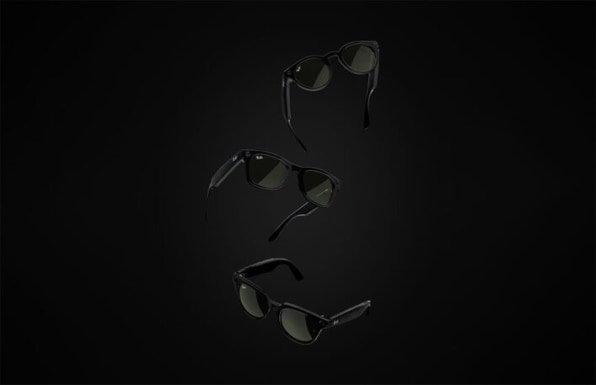
[Photo: courtesy of Ray-Ban]
Along with Ray-Ban’s iconic brand and look, EssilorLuxottica brought the ability to immediately scale the smart-glasses concept up into a product portfolio in a way that Facebook surely couldn’t have pulled off on its own. Ray-Ban Stories will be available in two sizes of Wayfarers as well as Meteor and Round frames, with five color choices and multiple lens types, including clear, Transitions, and prescription options. With the same technology available on so many types of Ray-Bans—20 in all—Stories might feel more like an upgrade option than a buying decision unto itself: As Basilico puts it, “for $100 more, you get a Wayfarer with superpowers.”
“Superpowers” might be overselling it a bit. I don’t have to be convinced that life has plenty of moments when you might want to capture still photos or video, and a smartphone would prove unwieldy. In my case, one prime example is when I’m pedaling an e-bike around the Bay Area; for the record, Zuckerberg says that he’s been using the glasses while skiing, surfing, canoeing, and teaching his daughter to fence.
But once I’d begun using the glasses to document my bike trips and other out-and-about experiences, I learned to temper my expectations. The Ray-Ban Stories’ two 5 MP cameras don’t deliver image quality that compares with that of a serious modern smartphone, even though Facebook says that it uses AI to enhance the results. (The dual cameras allow the Facebook View app for iOS and Android to perform some cute special effects with still photos, such as turning them into mini-videos that zoom in with a two-and-a-half-dimensional effect.) Nor does the 105-degree field of view match that of the human eye; I found that I couldn’t mentally crop the image I was looking at, leading to chopped-off heads in close-up people photos.

It’s also tricky to record an exact instant in time, because the glasses’ interface for taking still photos is far from snappy. You can choose between saying “Hey, Facebook, take a photo” (using a voice input feature called the Facebook Assistant) or holding down a button, and in either case it takes a couple of seconds until the capture happens. I ended up more inclined to shoot video, which maxes out at 30 seconds per clip with 1184-by-1184 resolution but requires less precision to create something worth saving.
Here’s a montage the View app made for me:
Managing the glasses’ storage and battery was also a larger responsibility than I anticipated. The onboard memory can hold a maximum of 35 30-second videos or 500 photos at a time, after which you must do a phone transfer to free up space. The battery life is rated at six hours of “moderate” use, but I drained the glasses in a couple of hours on one bike jaunt. You probably want to tote the charging case even though it’s a pocket-strainer.
I don’t mean to suggest that Ray-Ban Stories are more trouble than they’re worth. If you’re buying sunglasses anyway, the audio features might be worth the price of admission by themselves. (They’re great for listening in situations where you don’t want to block out all external noise, such as walking or biking city streets.) But you’ll be happiest with the cameras if you’re pretty forgiving on image quality—and don’t try to use them as anything like a wholesale replacement for your phone’s camera, inconvenient though it can sometimes be.
Dystopia averted
If Ray-Ban Stories were more wildly ambitious, more items on the long list of potential concerns about a Facebook computer you wear on your face would come into play. But their features aren’t even in the same Zip Code as the AR Facebook is also working on, where technologies such as facial recognition could easily go awry if mishandled. And Facebook and Ray-Ban have also backed away from some of the potentially creepy functionality that a pair of glasses with built-in cameras could enable.
For one thing, they made it difficult to use the glasses in a truly inconspicuous, privacy-violating manner. “There is an enormous responsibility for privacy, trust, security, transparency—not only for the person who buys that product, but also for everyone around them while they’re wearing it,” says Matthew Simari, director of product for Facebook Reality Labs.
Beyond the basic fact that the two camera lenses are in no way concealed, the sound effects they make as you use them—including a classic simulated shutter click—are faint but can’t be turned off. A prominent white LED near the right lens’s Ray-Ban logo glows whenever the cameras are in use: “That’s something that I think it’s worth noting smartphones don’t even do today,” says Zuckerberg. According to Simari, this LED is designed to be visible from up to 25 feet away, and some potential frame colors got nixed on the grounds that they provided insufficient contrast with it. (Another LED on the inside of the frames reminds the user when imagery is being captured.)
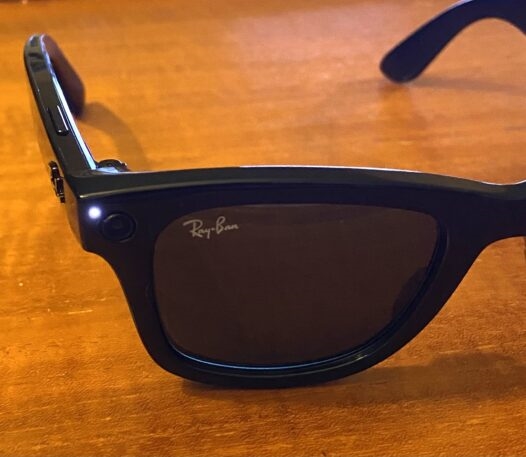
[Photo: Harry McCracken]
It’s certainly possible to take photos and videos with Ray-Ban Stories more discreetly than with a smartphone: As I roamed an outdoor antique fair, I used them to snap anything that caught my eye, and I’d be surprised if anyone noticed me touching the temple to initiate image capture. Buzzfeed’s Katie Notopoulos covered up the LED with tape and marker ink, then was told by a Facebook VP that doing so was a violation of the glasses’ terms of service. But anyone who’s set on taking covert photos for truly nefarious purposes, such as stalking or movie-theater piracy, has better options. And if the glasses sell well, they could become too familiar to be used without calling attention to themselves.
Other aspects of Ray-Ban Stories’ emphasis on privacy address the person wearing the glasses. Facebook says that it can’t see your photos or videos and doesn’t use them to target you with ads. You can shut off its ability to collect data such as the number of photos you take and the length of your videos, which it aggregates to better understand usage.The View app, which you use to manage the glasses, keeps a log of commands the Facebook Assistant heard you say; you can review them, delete them, or turn off the Assistant and control the glasses through taps, swipes, and button presses.
People get sensitive about anything that sounds too much like Facebook jacking into your brain, but Ray-Ban Stories don’t even jack directly into Facebook itself. (On iPhones, at least, this is partially due to Apple not doing much to facilitate wireless data transfers from external devices.) You can’t stream anything directly into your Facebook account: Getting photos and videos off the glasses and into the View smartphone app via Wi-Fi is a manual process, whereupon it’s just as easy to share them to TikTok or iMessage as Facebook or Instagram. (You do need a Facebook account to use the View app.)
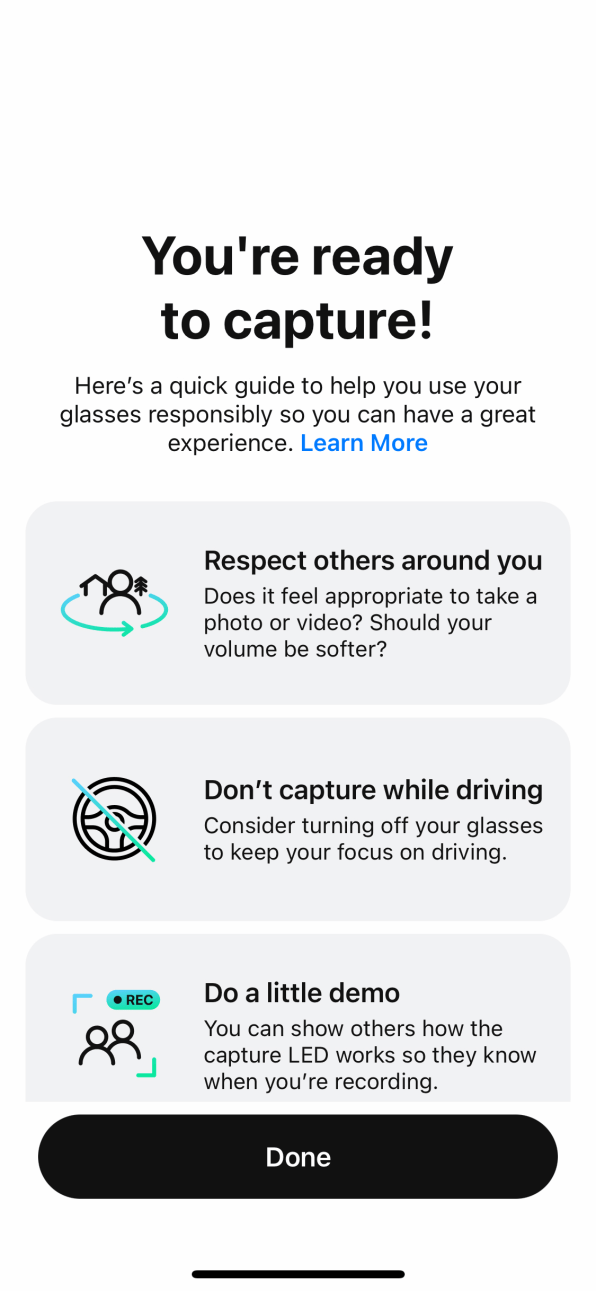
Of course, no matter how adroitly Facebook errs on the side of sidestepping potential privacy quagmires, people won’t respond solely to the design decisions that it and EssilorLuxottica have made. They will also have an instinctive reaction to the concept of cameras embedded into a pair of glasses—and if history is any guide, many will assume the worst. (Exhibit A: Google Glass, whose negative reception helped doom it as a consumer product.)
“[T]he truth is, wearable cameras freak people out,” my colleague Mark Wilson wrote back in 2016, when he was assessing Snap’s original Spectacles. Nothing has happened in the subsequent five years to ensure that Ray-Bans Stories won’t provoke their share of freakouts—especially among those inclined to be wary of anything that carries Facebook’s imprimatur.
Zuckerberg says that as people get to try Ray-Ban Stories for themselves and—he expects—find them cool and useful, the notion of taking photos with your glasses will reach a state of normalcy it hasn’t yet attained. “Part of the deal with any technology is that you see that value,” he says. “I don’t think we inherently want to go through our lives carrying a phone around in our pocket. We do it because it creates a lot of value for us.”
It’s at least possible that smart glasses like Ray-Ban Stories will follow a trajectory similar to that of the camera phone. Almost everyone has forgotten that when the first phones with built-in cameras hit the market in the mid aughts,they made a lot of people profoundly uneasy, provoked calls for new legislation, and even inspired new technologies designed to foil their use. It was only later, after camera phones gained widespread popularity, that they became relatively uncontroversial.
Does Zuckerberg grant that Facebook’s association with Ray-Ban Stories could make them a tougher sell? Not really. “I think that there are probably people who would be skeptical of any specific company,” he told me, though he also stressed that skeptics should understand that they won’t be used for ad targeting.
Still, it’s not like Facebook is pretending that smart glasses don’t have a comfort-level hurdle to clear. Its privacy webpage for RayBan Stories lists places where you should use the power switch to turn the glasses off, from locker rooms to houses of worship; the View app includes etiquette tips such as encouraging customers to demo how the now-recording LED works before taking pictures. Such features are about nudging anyone who buys the glasses into being “a good steward and thoughtful in their behavior,” says Simari.
The shape of glasses to come
None of the Facebook and EssilorLuxottica executives I spoke with took the bait when I gave them the chance to make predictions about how well Ray-Ban Stories will fare on the market. However, they all expressed optimism for it as a beachhead in a category that will matter: “In the near future, smart glasses will be a big part of our business,” says EssilorLuxottica wearables chief Basilico.
Zuckerberg, meanwhile, is thinking out through the early 2030s—and sees a place for the direct descendants of Ray-Ban Stories even though his ultimate goal is to build rich augmented reality into a similar form factor at the same price—with all-day battery life, yet—thereby ushering in an era when “phones are just a little less central in our lives.”
“I think it could be quite a long time before the full vision of what we talk about as augmented reality glasses becomes a $300 product,” he muses. “It may very well be that for another decade or so, there also are parallel smart glasses products. Maybe they have a display, maybe they don’t. But basically different tracks, so that the technology can be accessible to more people.”
So many impossible-to-predict developments could trip up this long-term plan. But consumer reaction to Ray-Ban Stories—good, bad, or indifferent—may tell us at least as much about its prospects as any prediction Mark Zuckerberg could make.
(39)

